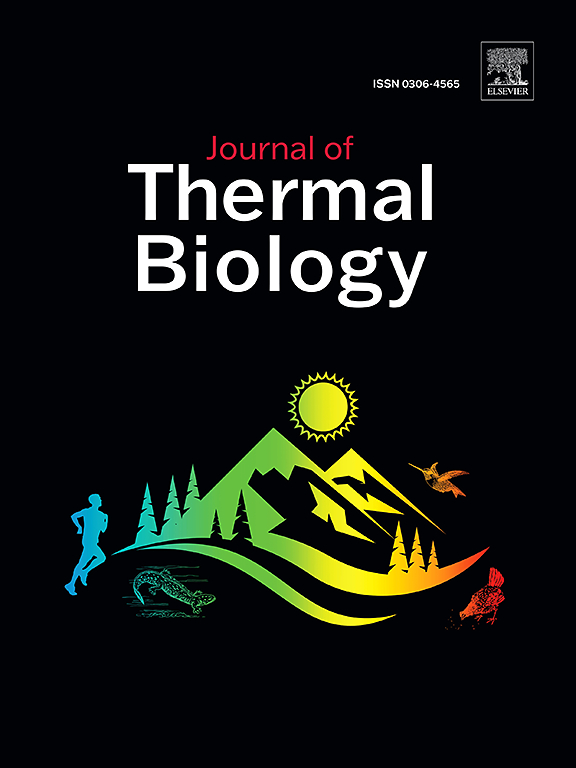高温下的生存:濒危物种青林短霉菌的稳态调节机制。
IF 2.9
2区 生物学
Q2 BIOLOGY
引用次数: 0
摘要
热应激严重影响了濒危冷水性鱼类秦岭蛙(Brachymystax tsinlingensis Li,1966)的保护和利用。本研究首先进行了热胁迫和恢复实验,结果表明,在热胁迫下,秦岭蛙的肠道仍具有自我调节能力。因此,研究人员利用转录组分析来研究沙丁鱼在温度波动时的平衡机制。结果表明,与对照组的表达水平相比,热胁迫组共发现了 5775 个差异表达基因(1725 个上调,4050 个下调),恢复组发现了 4312 个差异表达基因(2024 个上调,2228 个下调)。通过基因组富集分析(Gene Set Enrichment Analysis,GSEA)发现,柠檬酸循环(TCA循环)、氧化磷酸化、细胞凋亡、铁凋亡、局灶粘附和紧密连接通路在热应激过程中显著上调,而在恢复过程中则有所下降。结果表明,热胁迫会导致沙丁鱼铁蛋白沉积和细胞凋亡。然而,该生物能够在温度波动期间通过调节能量代谢以及肠道的屏障和免疫功能来维持体内平衡。这些发现有助于加深我们对冷水鱼在当今气候变化中的适应机制的理解。本文章由计算机程序翻译,如有差异,请以英文原文为准。

Surviving the heat: The homeostatic regulation mechanism of endangered Brachymystax tsinlingensis
Conservation and utilization of Brachymystax tsinlingensis Li, 1966 (B. tsinlingensis), an endangered cold-water fish, is severely hampered by heat stress. In this study, heat stress and recovery experiments were firstly performed and implied that the intestine of B. tsinlingensis remained capable of self-regulation under heat stress. Therefore, transcriptome analysis was used to investigate the homeostatic mechanisms of B. tsinlingensis during temperature fluctuations. The results showed that a total of 5775 differentially expressed genes (DEGs) (1725 up- and 4050 down-regulated) were identified in the heat stress group, and 4312 DEGs (2024 up- and 2228 down-regulated) were identified in the recovery group when compared to their expression levels in the control group. Through Gene Set Enrichment Analysis (GSEA), citrate cycle (TCA cycle), oxidative phosphorylation, apoptosis, ferroptosis, focal adhesion, and tight junction pathways were found to be significantly up-regulated during heat stress, and declined during the recovery process. The results illustrated that heat stress caused ferroptosis and apoptosis in B. tsinlingensis. However, the organism was able to maintain homeostasis during temperature fluctuations modulating its energy metabolism, as well as the barrier and immune functions of the intestine. These findings help to enhance our understanding of the acclimation mechanisms of cold-water fish in present-day climate change.
求助全文
通过发布文献求助,成功后即可免费获取论文全文。
去求助
来源期刊

Journal of thermal biology
生物-动物学
CiteScore
5.30
自引率
7.40%
发文量
196
审稿时长
14.5 weeks
期刊介绍:
The Journal of Thermal Biology publishes articles that advance our knowledge on the ways and mechanisms through which temperature affects man and animals. This includes studies of their responses to these effects and on the ecological consequences. Directly relevant to this theme are:
• The mechanisms of thermal limitation, heat and cold injury, and the resistance of organisms to extremes of temperature
• The mechanisms involved in acclimation, acclimatization and evolutionary adaptation to temperature
• Mechanisms underlying the patterns of hibernation, torpor, dormancy, aestivation and diapause
• Effects of temperature on reproduction and development, growth, ageing and life-span
• Studies on modelling heat transfer between organisms and their environment
• The contributions of temperature to effects of climate change on animal species and man
• Studies of conservation biology and physiology related to temperature
• Behavioural and physiological regulation of body temperature including its pathophysiology and fever
• Medical applications of hypo- and hyperthermia
Article types:
• Original articles
• Review articles
 求助内容:
求助内容: 应助结果提醒方式:
应助结果提醒方式:


